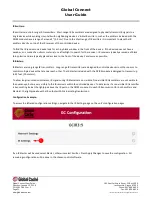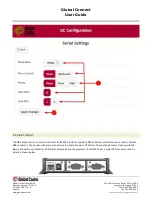
Global Connect
User Guide
Global Connect User Guide
160 East California Street, PO Box 1659
Effective: January 10, 2019
Jacksonville, Oregon 97530
PN: 103118-01 ver. 1
Phone: 541-899-4800
Page 3
Fax: 541-899-4808
www.globalcache.com
Information subject to change without notice.
3.0 PRODUCT ARCHITECTURE
Global Connect is a modular product. Each module has its
own IP address
, and configuration web pages. Modules can be
different sizes and occupy either 1, 2, or 3 slots in the unit chassis. The following chassis sizes are available:
•
19” freestanding enclosure with 10 available module slots
•
19” rack mount enclosure with 10 available module slots
•
15" freestanding enclosure with 10 available module slots
•
10.5" freestanding enclosure with 7 available module slots
•
7.5" freestanding enclosure with 5 available module slots
•
6" freestanding enclosure with 4 available module slots
•
4.5" freestanding enclosure with 3 available module slots
The modular design of Global Connect allows for simplified compatibility with previous Global Caché product drivers. Drivers
for previous products should generally be expected to work on Global Connect devices assuming the Global Connect
functionality existed on the product line the original driver was written for.
Note:
Previous Global Caché devices did not include an HDMI switch.
The modularity of the Global Connect also allows for numerous factory assembled product combinations. For orderable
configurations please see our web site at http://www.globalcache.com.
4.0 DISCOVERING MODULES ON THE NETWORK
When a unit is initially connected to the network, or after it has been reset to factory defaults, its modules will obtain an IP
address. To determine what IP address has been obtained, download and run iHelp from our website at
http://www.globalcache.com/downloads
. iHelp will discover any Global Caché units on the network and display their IP
address, and MAC address.
To learn more about the different ways Global Connect modules will obtain IP addresses visit section
5.3 Network Settings
.
4.1 CONFIGURATION WEB PAGES
Once the IP address of a module has been obtained the configuration pages can be loaded by typing the IP address of the
module into a browser.



































